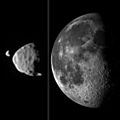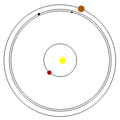Moons of Mars facts for kids
Mars has two small moons named Phobos and Deimos. These moons are much smaller than Earth's Moon. Scientists believe they might be asteroids that Mars's gravity pulled in. An astronomer named Asaph Hall discovered both moons in 1877.
Contents
Meet the Moons of Mars
Mars has two unique moons, Phobos and Deimos. They are named after characters from Greek mythology. Phobos means "fear," and Deimos means "panic." These names fit well because they were companions to the god of war, Ares, who is known as Mars in Roman mythology.
Phobos: The Closer Moon
Phobos is the larger of the two moons and orbits very close to Mars. It is shaped like a potato, not a perfect sphere. Phobos is so close to Mars that it orbits the planet faster than Mars spins! This means if you stood on Mars, you would see Phobos rise and set more than once a day.
Phobos is slowly getting closer to Mars. Scientists predict that in about 30 to 50 million years, Phobos will either crash into Mars or break apart into a ring of debris around the planet.
Deimos: The Farther Moon
Deimos is even smaller than Phobos and orbits farther away from Mars. It also has an irregular, lumpy shape. Because it's farther out, Deimos takes longer to orbit Mars. If you were on Mars, Deimos would appear to move very slowly across the sky.
Deimos is one of the smallest known moons in our Solar System. Its surface is smoother than Phobos's because most of its craters have been filled in by dust and rocks.
Comparing Phobos and Deimos
Here's a quick look at the two moons:
| Name | How to say it | Image | Diameter (average) | Mass |
|---|---|---|---|---|
| Phobos | FOE-bəs | 22.2 km | 1.08×1016 kg | |
| Deimos | DYE-məs | 12.6 km | 2×1015 kg |
| The Solar System | |||||||
|---|---|---|---|---|---|---|---|
|
|
|||||||
| Sun • Heliosphere |
Planets ☾ = moon(s) ∅ = rings |
Mercury | Venus | Earth ☾ | Mars ☾ | ||
| Jupiter ☾ ∅ | Saturn ☾ ∅ | Uranus ☾ ∅ | Neptune ☾ ∅ | ||||
| Dwarf planets | Ceres | Pluto ☾ | Haumea ☾ | Makemake | |||
| Eris ☾ | |||||||
| Small Solar System bodies |
Asteroids (minor planets) |
Groups and families: Vulcanoids · Near-Earth asteroids · Asteroid belt Jupiter Trojans · Centaurs · Neptune Trojans · Asteroid moons · Meteoroids · Pallas · Juno · Vesta · Hygiea · Interamnia · Europa |
|||||
| See also the list of asteroids. | |||||||
| Trans- Neptunians |
Kuiper belt – Plutinos: Orcus · Ixion – Cubewanos: Varuna · Quaoar · Huya |
||||||
| Scattered disc: Sedna | |||||||
| Comets | Periodic comets and non-periodic comets Damocloids · Oort cloud |
||||||
| See also the list of solar system objects | |||||||
Images for kids
-
Curiosity's view of the Martian moons: Phobos passing in front of Deimos – in real-time (video-gif, 1 August 2013)
-
The telescope used by Asaph Hall in the discovery of the Martian moons.
-
Apparent sizes of the moons of Mars, Deimos and Phobos, and the Moon as viewed from the surface of their respective planets (Mars' moons imaged by the Curiosity rover, 1 August 2013)
-
Phobos, with Stickney Crater on the right (2003).
See also
 In Spanish: Satélites de Marte para niños
In Spanish: Satélites de Marte para niños









